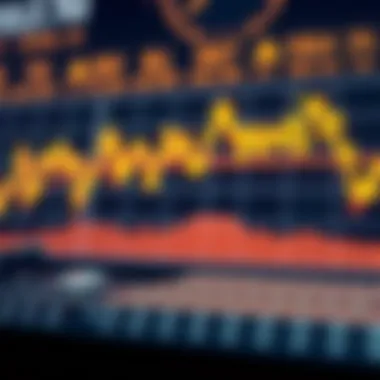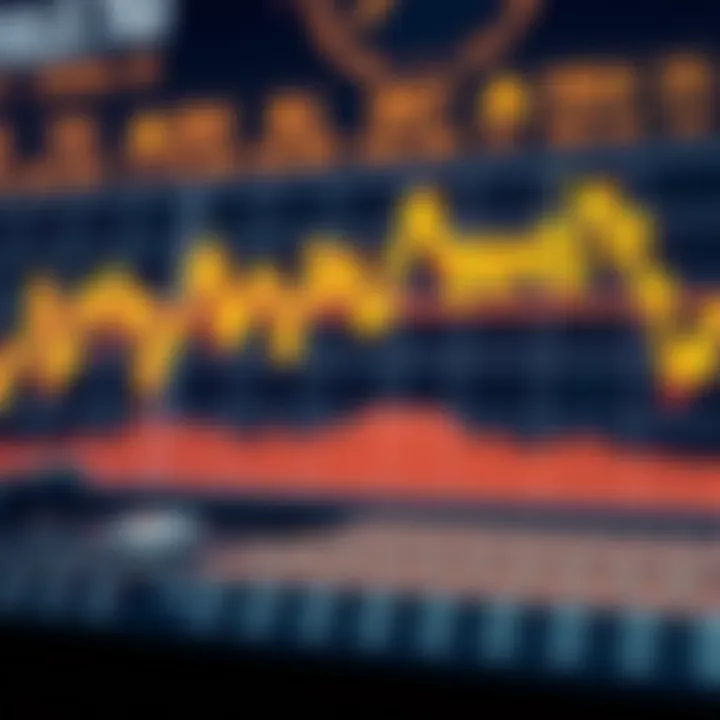Mastering Gold Trading on the MT4 Platform


Intro
Gold has been a cornerstone of investment many centuries. Through the ups and downs of market trends, this shiny metal remains a popular choice among traders using MetaTrader 4 (MT4). It's not just about buying and selling; it's a dance of understanding market psychology, fundamentals, and timely execution.
Before diving into the specifics, it's essential to grasp why gold holds such significance. Gold is often viewed as a safe haven – a protective asset during economic downturns and inflationary periods. When stocks stumble and uncertainty looms, investors often flock to gold, which adds a layer of complexity to trading it. For seasoned traders and newcomers alike, understanding gold trading on platforms like MT4 is vital to navigating the tumultuous waters of global markets effectively.
In the following sections, we will illuminate the key definitions, insights, and strategies pertaining to gold trading in MT4. By weaving together crucial information, examples, and practical tips, this article aims to guide traders in enhancing their trading skills.
Now, let’s begin with the essential definitions that lay the groundwork for understanding gold trading.
Understanding Gold as an Investment
Gold has always stood out as a unique asset class in the realm of investments. Its allure has captivated both seasoned investors and newcomers to the financial markets alike. The significance of understanding gold as an investment cannot be understated. As a trader on MetaTrader 4, familiarizing oneself with the nuances of this precious metal offers not just a competitive edge, but a deeper insight into why gold holds value in diverse economic climates.
Historical Significance of Gold
Throughout human history, gold has played a pivotal role. From ancient civilizations using it as currency to modern markets viewing it as a store of value, this metal's historical significance is multifaceted. Empires rose and fell based on their gold reserves; it was literally the backbone of economies. When times were tough, such as during financial crises or wars, gold was often the safe haven investors turned to. Its scarcity linked to its enduring value makes it a timeless asset. Clearly, gold isn’t just a metal; it’s a testament to economic resilience.
- Ancient Civilizations: The Egyptians, Romans, and Greeks all treasured gold, using it not just for adornment but as an instrument of trade.
- Economic Stability: In times of uncertainty, gold often retains its worth. For instance, during the Great Depression, many turned to gold as a safeguard for their wealth.
This historical perspective sets the stage for current investment strategies and highlights why gold retains a critical role in both portfolio diversification and risk management today.
Why Investors Choose Gold
The decision to invest in gold typically hinges on several rational factors. Investors gravitate towards gold for its unique characteristics that often shield them from volatile market conditions. Here are some compelling reasons:
- Inflation Hedge: Gold is often viewed as an effective way to mitigate inflation. When fiat currencies lose purchasing power, gold tends to retain or even increase in value over time.
- Portfolio Diversification: Gold often shows low correlation with other asset classes like stocks and bonds. Thus, including gold in a portfolio can help in spreading risk.
- Global Demand: Nations like India and China are significant consumers of gold, driven by cultural factors and rising wealth. This demand supports gold prices, making it a strategic investment.
- Tangible Asset: Unlike digital currencies or stocks, gold is a physical asset. Many investors feel secure owning something they can hold in their hands.
For both new and experienced traders on platforms such as MT4, understanding these factors is crucial in formulating a robust trading strategy. The ongoing global dynamics will often test these principles, making it essential to stay updated and informed.
Prolusion to MetaTrader
When it comes to trading gold, MetaTrader 4 (MT4) is a platform that has become synonymous with flexibility and user-friendliness. As we embark on this journey into gold trading, understanding how to navigate MT4 is essential. The software is not just a trading interface; it’s a powerful tool that provides traders with the insights they need to make informed decisions.
MT4 is particularly favored due to its robust features that support a variety of trading styles, making it suitable for everyone from the cautious investor to the aggressive trader. Its charting capabilities, technical indicators, and automated trading options set it apart from other platforms. By incorporating these elements, it allows traders to analyze market trends and craft personalized strategies that align with their financial goals.
Moreover, the community surrounding MT4 is a treasure trove of information. From forums like Reddit to trading blogs, traders frequently share tips and strategies. This communal support can be invaluable for beginners trying to find their footing as well as seasoned investors looking to refine their techniques. Given the evolving dynamics of the markets, knowledge sharing is a critical advantage that should not be overlooked.
In the upcoming sections, we’ll unravel the specifics of what makes MT4 crucial for trading gold, exploring its myriad features and how to set it up effectively for your trading needs.
Overview of MT4 Features
MT4 comes equipped with an impressive array of features that significantly enhance the trading experience. Some key elements include:
- Advanced Charting Tools: MT4 offers various chart types and timeframes, allowing you to analyze past price movements and forecast future trends.
- Technical Indicators: The platform supports a plethora of built-in indicators like Moving Averages, MACD, and RSI. You can also integrate custom indicators if you're familiar with coding.
- Automated Trading: Traders can utilize Expert Advisors (EAs) to automate their trades based on predefined criteria, ensuring they never miss an opportunity, even while away from the screen.
- User-Friendly Interface: The layout is intuitive, making it easier for both newcomers and experts to navigate without feeling overwhelmed.
- Multi-Language Support: Trading on MT4 is accessible to a diverse group of users thanks to its support for multiple languages.
These features collectively create an environment conducive to effective gold trading. They allow traders to not just react to market movements, but to anticipate and strategize accordingly.
Setting Up MT4 for Gold Trading
Now that we have an understanding of the features, let's discuss how to set up MT4 specifically for gold trading. Here’s a straightforward approach to get you started:
- Download MT4: Visit the official MetaTrader website or your broker's page to download the platform. Installation is generally straightforward and does not take long.
- Create Trading Account: Upon launching the software, you’ll need to create a trading account. Some brokers might offer demo accounts for practice, which is highly recommended if you’re new to gold trading.
- Configure Settings: Familiarize yourself with the settings. Go to the tools section to customize aspects such as alerts and notifications according to your preferences.
- Access Gold Trading Options: Look for trading pairs that include gold, often denoted as XAU/USD or XAU/EUR. This information can generally be found in the market watch section.
- Implement a Trading Strategy: Whether you plan to adopt a scalping technique, swing trading, or a long-term approach, ensure you have a strategy that takes advantage of MT4's features. You might want to test this out in a demo account before committing real funds.
By following these steps, you will be positioned to navigate the gold markets effectively, using the tools MT4 provides to your advantage. These preparations ensure that when the market shifts, you’ll be ready to act with precision.
Technical Analysis of Gold Markets
Technical analysis plays a pivotal role in understanding gold trading, especially on platforms like MT4. It involves analyzing price movements and market trends through various indicators and chart patterns. For both novice and experienced traders, mastering technical analysis can significantly enhance decision-making and trading strategies.
By focusing on historical price data and market behavior, traders can identify potential entry and exit points. Moreover, technical analysis provides a framework to gauge market sentiment and volatility around gold, which is crucial due to its sensitivity to economic shifts and geopolitical events. Without a grasp of technical indicators, one may navigate the gold market like a ship lost at sea, adrift without direction.
Understanding Price Charts


Price charts are fundamental to technical analysis as they visually depict how gold prices have changed over time. Traders can choose from various types of charts, such as line charts, bar charts, and candlestick charts. Each type has its own strengths, but many traders prefer candlestick charts due to their ability to convey more information in each time period.
- Line Charts: Simple and effective, ideal for tracking movement over time.
- Bar Charts: Provide high, low, open, and close prices, offering a richer view than line charts.
- Candlestick Charts: Offer even more, including market sentiment through patterns of open, close, high, and low prices.
Using these charts allows traders to spot patterns, such as head and shoulders or double tops, which serve as indicators of potential price movements.
"A picture is worth a thousand words; a price chart can give you thousands of insights."
Key Indicators for Gold Trading
There are several crucial indicators traders employ to assess gold's price movements. Understanding these indicators can provide deeper insights into market conditions:
- Moving Averages: These smooth out price data to help identify trends over a specific period. Simple moving averages (SMA) are common, but exponential moving averages (EMA) can give more weight to recent prices, making them more responsive to changes.
- Relative Strength Index (RSI): This momentum oscillator measures the speed and change of price movements. A high RSI indicates that gold may be overbought, while a low RSI suggests it may be oversold.
- Fibonacci Retracement Levels: Traders use these levels to identify potential areas of support or resistance based on the Fibonacci sequence. This technique helps to predict future price movements based on historical data.
- MACD (Moving Average Convergence Divergence): A trend-following momentum indicator that shows the relationship between two moving averages of gold's price. It can signal potential buy or sell opportunities.
In summary, weaving together insights obtained from price charts and technical indicators allows traders to formulate more informed strategies, honing in on opportunities to optimize their gold investments.
Trading Strategies for Gold in MT4
When it comes to trading gold, having a well-reasoned strategy is critical. Not only can a solid strategy help you maximize potential profits, but it can also minimize risks associated with volatile markets. MT4 provides various tools and features that make it easier to implement tailored strategies. Understanding how to utilize these strategies is vital for both novice and seasoned investors seeking to capitalize on gold's market movements.
The beauty of trading strategies is that they allow traders to create a blueprint that aligns with their individual risk appetites and investment goals. With gold being a safe-haven asset and a store of value, it is important to apply the right approach to harness its full potential.
Scalping Techniques
Scalping is a trading style that involves making numerous trades over the course of a day, often holding positions for only a few minutes. For gold traders using MT4, scalping can be an enticing option due to the asset's price fluctuations. Here are some compelling reasons why scalping techniques can be effective:
- Quick Gains: Traders aim to profit from small price changes that occur in quick succession.
- Frequent Opportunities: Since the gold market is active, opportunities may present themselves regularly throughout the trading day.
- Leveraged Trading: MT4 allows the use of leverage, which means you can amplify your trading position and potentially enhance gains.
However, scalping requires discipline and a stringent adherence to your strategy. Speed is of the essence, and traders must be quick on their feet to execute trades effectively.
Swing Trading Approaches
Swing trading enables investors to capitalize on larger price movements by holding onto their positions for several days or even weeks. This technique suits gold trading quite well, as it allows traders to take advantage of both upward and downward price trends over time. Some strategies that are common in swing trading include:
- Trend Following: Traders who identify prevailing trends can execute trades in the direction of the trend, potentially securing notable profits.
- Breakout Strategies: Waiting for price breakouts—where the asset price exceeds a specified resistance or support level—can lead to robust trading opportunities.
- Fibonacci Retracement Levels: Many swing traders utilize Fibonacci retracement levels to identify potential reversal points in price movements. This technical tool can help set entry and exit points effectively.
Swing trading requires patience and a good understanding of market dynamics. It’s less frenetic than scalping but still demands a proactive mindset.
Long-Term Investment Strategies
For investors looking at gold as a long-term asset, certain strategies can be beneficial to follow. Gold tends to act as a hedge against inflation and currency devaluation. Here are a few approaches worth considering:
- Buy-and-Hold: This straightforward strategy involves purchasing gold and holding onto it for an extended period, allowing the investment to grow with market trends over time.
- Dollar-Cost Averaging: By investing fixed amounts at regular intervals, investors can reduce the impact of market volatility. This strategy can lessen the risk associated with large market shifts.
- Monitoring Economic Indicators: Long-term traders should pay attention to key economic indicators that impact gold prices, such as interest rates, inflation, and geopolitical developments.
Incorporating these long-term strategies into your trading plan can help build a resilient portfolio that accounts for market fluctuations while aiming for long-term gains.
Trading gold in MT4, whether through scalping, swing trading, or long-term strategies requires attention, patience, and knowledge. Keeping a keen eye on market trends and economic indicators will ultimately aid in making informed decisions and optimizing your trading experience.
Risk Management in Gold Trading
Effective risk management is a cornerstone of trading, particularly when dealing with assets as volatile as gold. For investors navigating the turbulent waters of gold trading in MetaTrader 4, understanding risk mitigation strategies not only safeguards significant capital but also enhances overall trading performance. Within this context, several specific elements underscore the importance of managing risks when trading gold:
- Market Volatility: Gold prices can swing dramatically based on global economic conditions, geopolitical events, or shifts in investor sentiment. Investors must be prepared for rapid changes, and sound risk management practices can cushion the blow from unexpected market movements.
- Capital Preservation: The primary goal for any savvy investor should be to protect their capital. Risk management strategies aim to keep losses to a minimum, allowing traders to remain in the game and capitalize on future opportunities.
- Psychological Comfort: Knowing that there are measures in place to protect against potential losses can lead to improved decision-making. When traders feel secure, they are less likely to make impulsive and emotional decisions, which often lead to a downward spiral in trading success.
Effective risk management encompasses not only the identification of potential risks but also practical strategies designed to address them.
Identifying Potential Risks
In gold trading, potential risks will sprout up like daisies in springtime. First and foremost, market volatility poses a significant threat. Rapid fluctuations in the price of gold can catch traders off guard, leading to poor investment choices.
Some common risks include:
- Political Uncertainty: Political events can influence gold prices dramatically. Election results or changes in government policy can shift market sentiment and create uncertainty.
- Economic Data Releases: Important economic indicators, like employment reports or inflation rates, can sway prices significantly. Traders must keep an eye on scheduled releases to avoid being blindsided by sudden market movements.
- Interest Rate Changes: Central banks influence gold values through interest rate decisions. Rising rates can dampen demand for gold as a non-yielding asset, pushing prices down.


Understanding these various risks allows traders to develop an awareness that is crucial for effective navigation within the gold market.
Setting Stop-Loss Orders
One of the most powerful tools in a trader's arsenal is the stop-loss order. This mechanism acts as a safety net, automatically triggering a sale when the price of gold dips to a predetermined level. It ensures losses stay within manageable limits while allowing gains to run as long as possible.
Using stop-loss orders effectively requires careful consideration of a few factors:
- Setting the Right Levels: Determining where to position stop-loss orders is vital. Placing them too close to the market price can result in premature exits, while setting them too far may expose the trader to significant losses.
- Adapting to Market Dynamics: Gold prices move based on numerous external factors. Adjusting stop-loss levels in response to changing market conditions is a smart tactic. This flexibility can potentially shield your capital while riding favorable trends.
- Types of Stop-Loss Orders: Traders can employ different types, like traditional fixed stop-loss orders, trailing stops, or guaranteed stop-loss orders. Each serves unique purposes and allows traders to tailor their risk management approach based on individual preferences.
"In trading, taking calculated risks is essential; the goal is not just about winning but about preserving your hardest-earned capital."
Analyzing Economic Indicators Impacting Gold Prices
Understanding the economic indicators that influence gold prices is crucial for anyone involved in gold trading, particularly on the MetaTrader 4 platform. Economic indicators serve as essential tools that provide insight into the overall health of the economy, which in turn affects investor behavior and market dynamics. By keeping a close eye on these indicators, traders can craft more informed strategies and better anticipate price movements.
Global Economic Conditions
The state of the global economy plays a significant role in determining gold's appeal and, consequently, its price dynamics. When economies face turbulence, such as recessions or financial crises, gold is typically seen as a safe haven. Investors rush to buy gold, driving prices up due to heightened demand.
Several factors can signal global economic conditions to traders:
- Inflation Rates: High inflation erodes purchasing power, leading investors to seek refuges such as gold, which tends to hold value better than collapsing fiat currencies.
- Employment Data: Strong employment figures may suggest a robust economy, which might reduce the immediate appeal of gold as a safe investment.
- Geopolitical Events: Political instability or tensions in regions rich in resources can lead to a spike in gold prices as investors panic and secure what they consider a stable store of value.
- Commodity Prices: Changes in other commodity prices, such as oil, can also affect gold. For instance, a surge in oil prices may lead to inflation, driving demand for gold.
Traders should monitor resources like Trading Economics or the International Monetary Fund for real-time data and analyses of global economic conditions.
Central Bank Policies
Central banks wield substantial influence over gold prices through their monetary policies. When central banks, like the Federal Reserve in the United States, adjust interest rates, it can impact gold investment decisions significantly. Here's how:
- Interest Rates: Generally, lower interest rates lead to decreased opportunity costs of holding non-yielding assets like gold. Consequently, when rates are low, investors may flock to gold, propelling prices higher.
- Quantitative Easing: Central banks may resort to purchasing assets to inject liquidity and stimulate the economy. This action often leads to increased inflation expectations, increasing gold's allure as a hedge against currency devaluation.
- Gold Reserves: Changes in gold reserves held by central banks can influence market perception. When central banks purchase gold to diversify their reserves, it can create bullish sentiments in the market, prompting individual investors to follow suit.
To bounce back to central banks’ movements, it’s advisable to refer to Federal Reserve Economic Data or news releases from the European Central Bank. These resources help traders stay informed about pivotal policy changes affecting gold prices.
"Monitoring economic indicators and understanding their implications is not just smart trading; it's essential for survival in the volatile world of gold trading."
Incorporating these elements into your trading strategy can refine your approach and enhance your decision-making process in the fluctuating landscape of gold trading.
Gold Trading Platforms Comparison
When venturing into gold trading, the platform you choose can significantly influence your overall experience and success. In the realm of investing, selecting the right trading platform is akin to using the appropriate tools for a job; it can either make your efforts seamless or present challenges that may hinder your strategy. Each platform comes with its own set of features and quirks, and understanding these differences can lead to more informed decisions.
Differences Between MT4 and MT5
The transition from MetaTrader 4 to MetaTrader 5 is a hot topic among traders. Both platforms serve a similar purpose but cater to different needs. While MT4 is renowned for its simplicity and is tailored specifically for forex trading, MT5 offers additional capabilities, making it more versatile for various asset classes, including commodities like gold.
Key Differences:
- User Interface: MT4's interface is simpler and more user-friendly, making it ideal for beginners. MT5, in contrast, incorporates a more complex layout with added features that may feel overwhelming to new users.
- Trading Tools: MT5 supports more technical indicators and offers tools such as market depth. This can be a boon for seasoned traders who thrive on detailed market analysis.
- Order Types: MT5 allows for more order types, including pending orders such as Buy Stop Limit and Sell Stop Limit. This flexibility can enhance trading strategies, especially when dealing with fast-moving gold price fluctuations.
- Execution Speed: MT5 offers superior execution speed, which can be crucial in a highly volatile market like gold.
"Choosing the right platform is just as critical as finding the right strategy. It’s the foundation where all your analysis and decisions rest."
Pros and Cons of Various Platforms
When comparing trading platforms for gold, it’s essential to weigh their advantages and disadvantages.
Pros:
- Accessibility: Most platforms are easily accessible on various devices. Whether you're using a desktop, tablet, or smartphone, you can manage your trades on the go.
- Range of Tools: A good trading platform usually comes with a suite of analytical tools designed to aid traders in making informed decisions. This includes real-time charts, technical indicators, and news feeds.
- Community Support: Platforms like MT4 have a large user base and community. This means there are numerous forums and resources available, such as on Reddit or various Facebook groups, allowing traders to share insights and strategies.
Cons:
- Complexity: Advanced platforms may offer extensive features, but they can be intimidating for beginners. It might take time to adapt and fully understand how to use advanced trading tools effectively.
- Costs: Some platforms may charge hidden fees or commissions, impacting the overall profitability of your trades. It’s essential to read the fine print and compare costs across platforms.
- Compatibility Issues: Not all platforms integrate seamlessly with every broker. Ensuring your selected platform works with your broker is a key consideration to avoid trading delays.


In summary, before jumping into gold trading, it's advisable to thoroughly evaluate the platforms available. Make sure to consider your personal trading preferences, the specific features you'll need, and how each platform aligns with your trading strategy. Notably, resources like Investopedia or Yahoo Finance offer insights and comparisons that could further guide your decision-making process.
Common Mistakes in Gold Trading
When diving into the gold trading arena, it's easy to make missteps that can cost both time and money. Understanding these common pitfalls is crucial for both new and seasoned investors. Avoiding blunders not only enhances trading performance but also builds confidence in using the MetaTrader 4 platform. The intricate dance of gold trading deserves careful attention to detail, as it can transform mere speculation into calculated success.
Emotional Trading Decisions
Emotions can be the unseen puppet master of trading outcomes. It’s often said that trading should be a business, not a gamble, but the heart doesn’t agree with that all the time. Let's get down to brass tacks. Many traders let their feelings dictate decisions, driving them to buy high in excitement or sell low in fear. It’s the classic case of panic selling or greedy buying.
- Greed sets in when a trader sees gold soaring. They might think, "This is going to the moon!" and buy in at inflated prices.
- On the flip side, fear creeps in at the sight of falling prices, resulting in hasty exits from positions that could have recovered.
"Trading is 90% psychological and 10% strategy." - Unknown
The remedy? Develop a rock-solid trading plan that includes clear entry and exit points. Being disciplined can steer one clear of emotional turbulence. Incorporating tools for self-regulation, like journaling trades and strategies, can keep emotions at bay. Having a structured approach ensures that every decision is well-founded rather than impulsive.
Ignoring Technical Analysis
Another common blunder is dismissing the importance of technical analysis. Relying solely on instincts or news headlines to make decisions can leave traders floundering without a compass. The trend lines, support, resistance points, and indicators are there for a reason—they tell a story. When traders fail to engage with these tools, they miss critical insights that could guide their strategies.
For instance, consider the Moving Average Convergence Divergence (MACD) or Relative Strength Index (RSI). These indicators provide valuable information on trends and potential reversals. By shouting out signals, they can inform decisions on when to buy or sell, helping traders position themselves correctly in the market.
Some points to keep in mind regarding technical analysis:
- Chart patterns can signal when it's time to enter or exit trades.
- Recognizing volume patterns can reinforce whether a move is genuine or a false alarm.
- Trading on gut feelings instead of data can be a slippery slope.
Incorporating technical analysis into trading routines will not only illuminate the path forward but also bolster a trader's confidence in executing strategies on the MT4 platform. The charts are not just numbers; they are a trader’s map to navigation, providing insights that can lead to more informed and practical trading decisions.
Future Trends in Gold Trading
Gold trading continues to evolve, influenced by myriad factors that shape the financial landscape. As the demand and supply dynamics shift, it is crucial for both beginner and seasoned investors to stay abreast of these trends. Not only does understanding future trends in gold trading guide investment decisions, but it also aids in mitigating risks often associated with market fluctuations.
Impact of Digital Assets
In recent years, digital assets have emerged as a significant force in the financial world, reshaping investor attitudes toward gold. Cryptocurrencies like Bitcoin and Ethereum have attracted many, leading traders to reevaluate how they perceive traditional assets, including gold. This phenomenon isn't merely a passing fad, but rather a sign of changing investor sentiment.
- Diversification Strategy: Many traders are now considering digital assets as part of a diversified portfolio that includes gold. The idea is that while gold offers stability during market downturns, cryptocurrencies can potentially yield high returns in periods of rapid growth.
- Blockchain Technology: The integration of blockchain technology has paved paths for gold-backed digital currencies. By creating a direct tie between gold and digital assets, investors gain transparency and security, likely more than they would with traditional trading methods.
"The intersection of digital currencies and gold could provide new avenues for investment strategies and risk management."
For gold traders, keeping an eye on how digital assets interact with market sentiment and pricing can illuminate future trading opportunities and strategy adjustments.
Shifts in Global Demand
Global demand for gold is an intricate chess game influenced by cultural, economic, and geopolitical factors. As the world becomes increasingly interconnected, these shifts are poised to play a pivotal role in gold trading.
- Emerging Markets: Major economies like India and China have shown a robust appetite for gold, often driven by cultural significance and rising middle-class wealth. This demand could potentially lift gold prices as these markets continue to grow.
- Central Bank Purchases: Central banks around the world have been net buyers of gold in recent years. The strategic accumulation of gold reserves as a safeguard against inflation and currency devaluation reflects a broader trend that could lead to sustained upward pressure on gold prices.
- Financial Uncertainty: As economic uncertainties continue to loom on the horizon, including inflationary pressures and trade disputes, gold is likely to remain a safe haven for investors seeking stability. This historical function of gold as a protective asset is witnessing renewed emphasis, particularly in times of heightened market volatility.
As such, understanding the intricacies of these shifts allows investors to position themselves strategically in the gold market, preparing for both bullish and bearish scenarios.
In summary, keeping a finger on the pulse of future trends in gold trading is essential for informed decision-making. The confluence of digital assets and evolving global demand presents unique opportunities that savvy investors should not overlook.
Finale
In the dynamic realm of gold trading, especially within the MetaTrader 4 platform, knowing how to navigate effectively is paramount. As we've discussed through this article, there are multiple layers that contribute to successful gold trading, from understanding the fundamentals to leveraging advanced strategies.
Key Takeaways
- Gold's Historical Perspective: Recognizing the historical significance of gold can help investors appreciate its role as a safe haven, especially during turbulent times.
- Importance of Technical Analysis: Proficiency in reading charts and utilizing indicators cannot be overstated. Being able to identify trends is a skill that pays off significantly in trading.
- Risk Management Is Crucial: Strategies like setting stop-loss orders are not merely suggestions; they are necessary practices to shield your investments from unexpected market volatility.
- Trading Strategies Matter: Whether it’s scalping, swing trading, or a long-term approach, each method serves its purpose. Investors should align their strategy to their personal risk tolerance and market outlook.
- Continuous Learning: Staying informed about global economic conditions and central bank decisions can equip investors with the foresight needed to navigate gold price fluctuations.
"In trading, as in life, what goes up must come down; the key is how well you prepare for both extremes."
Continuous Learning and Adaptation
The financial landscape is a moving target, with gold trading being no exception. Investors must adopt a mindset that embraces continuous learning and adaptation. This is essential because trends in economics, technology, and consumer behavior evolve, and your trading strategies should too.
- Knowledge is Power: Regularly update your understanding of the markets, economic indicators, and new trading technologies. Resources like academic articles, webinars, and trading forums can provide invaluable insights.
- Feedback Loop: Analyze your trading outcomes. What worked? What didn’t? This reflection can help you hone your strategies over time.
- Engage with Community: Platforms like Reddit and local trading groups can offer a wealth of perspectives and experiences, fostering your development as an investor.
- Adapt to Tools and Technologies: Tools and platforms are constantly being updated. Familiarize yourself with new features in MT4 and integrate them into your trading routine where beneficial.
In summation, understanding the nuances of gold trading on MT4 is not a one-time endeavor but a lifelong journey. Churning through the complexities may seem daunting, but with persistent learning and a strategic mindset, traders can navigate gold markets effectively.







